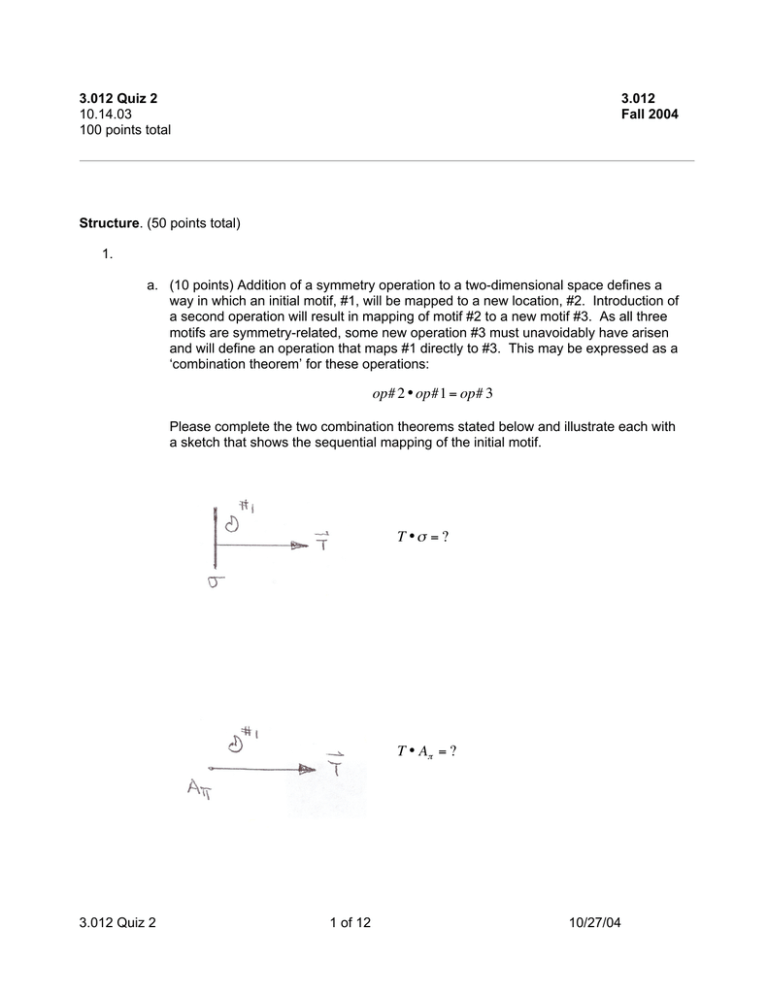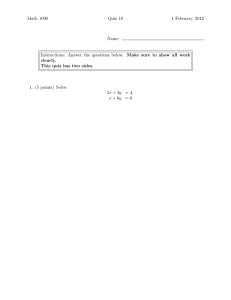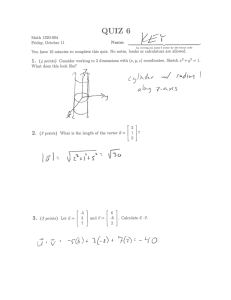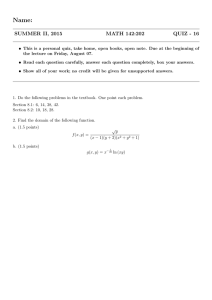10.14.03 100 points total 1.
advertisement

3.012 Quiz 2 10.14.03 100 points total 3.012 Fall 2004 Structure. (50 points total) 1. a. (10 points) Addition of a symmetry operation to a two-dimensional space defines a way in which an initial motif, #1, will be mapped to a new location, #2. Introduction of a second operation will result in mapping of motif #2 to a new motif #3. As all three motifs are symmetry-related, some new operation #3 must unavoidably have arisen and will define an operation that maps #1 directly to #3. This may be expressed as a ‘combination theorem’ for these operations: op# 2 • op#1 = op# 3 Please complete the two combination theorems stated below and illustrate each with a sketch that shows the sequential mapping of the initial motif. € T •σ = ? € T • Aπ = ? € 3.012 Quiz 2 1 of 12 10/27/04 b. (16 points). A pair of translationally-periodic two-dimensional patterns are on the following sheets. An extra copy of each is provided so that you can use on for scratch work. Directly on the sheets: i. Sketch in an array of bold dots as lattice points that show the translational periodicity. ii. Connect the lattice points to indicate the conventional unit cell. iii. Sketch in, using conventional symbols, the location of all symmetry elements that are present within the cell. c. Bonus: a 3.012 challenge: State the symbol for the plane group displayed by each of the patterns: one bonus point for each if you are correct, no loss of points if you are wrong. 3.012 Quiz 2 2 of 12 10/27/04 3.012 Quiz 2 3 of 12 10/27/04 2. a. (8 points). For a cubic crystal with a lattice constant a = 12.4 Å, compute the spacing of the (1 4 0) planes. 3.012 Quiz 2 7 of 12 10/27/04 c. (8 points). Let us now consider diffraction from a one-dimensional crystal with a lattice constant a = 10 Å. The crystal is irradiated with an X-ray beam having a wavelength λ that is incident on the crystal at an angle µ of 30°. Diffraction must now be described by the Laue equation for scattering by a one-dimensional crystal: cosν = cos µ + mλ a€ where m is an integer and ν is the angle between the lattice row and the diffracted beam. Let us now ask the same question as in problem 2(b): Is there a value or range of values of € λ for which this crystal would be unable to produce any scattered beams at all? € 3.012 Quiz 2 9 of 12 10/27/04 3. Thermodynamics. (50 points). a. (5 points each part, 30 points total) True-False-explanation. Read the statements below and decide if they are completely true, or false based on your understanding of thermodynamics. Explain your choice of true/false (in 1 or 2 brief sentences), and if necessary, show an equation that supports your statement. i. A first-order phase transition can be identified by a discontinuous increase in the value of several variables of a system at the transition temperature, including volume, heat capacity, enthalpy, and entropy. ii. If the entropy change of a first-order phase transformation at constant pressure ΔStrans is positive for stability, then the enthalpy of transformation ΔHtrans must also be positive. iii. Minimizing the Helmholtz free energy of the system + its surroundings under conditions of constant temperature and volume to determine the equilibrium state is equivalent to maximizing the entropy of the universe, in obedience to the second law. 3.012 Quiz 2 10 of 12 10/27/04 iv. The entropy of materials decreases as temperature decreases, but if a hot liquid is placed in thermal contact with a cold reservoir, the liquid will spontaneously cool to the temperature of the reservoir, and this spontaneous process will not violate the second law. v. The work of polarizing an anisotropic single-crystal material by application of an electric field will depend on the direction in which the field is applied relative to the crystal orientation. vi. For an isolated system of two materials A and B brought into thermal contact, the entropies of the subsystems will be maximized at equilibrium, but the internal energies will not necessarily reach a maximum or minimum. 3.012 Quiz 2 11 of 12 10/27/04 b. (20 points) Consider a liquid comprised of four components A, B, C, and D, mixed homogeneously in a single phase at constant temperature and pressure. The molecules can undergo an interconversion reaction: A+ B↔C+ D The chemical potentials of the components are always positive ( > 0). 3.012 Quiz 2 (i) If the chemical € potential of C in the system is initially greater than that of all the other components, will an increase in the number of B molecules in the system occur spontaneously? Show how your answer is proven by the equilibrium/spontaneity condition for this system. (ii) Write an expression showing the relationship between the chemical potentials of each species at equilibrium. 12 of 12 10/27/04



